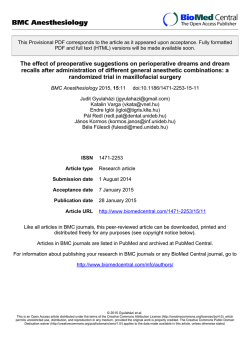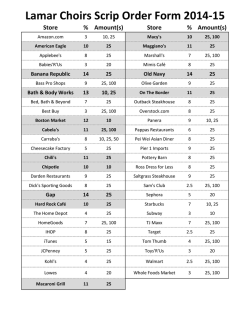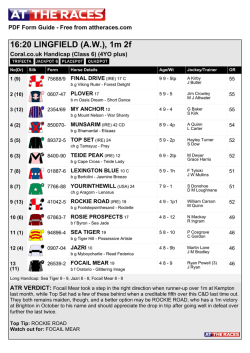
PDF (635 kB) - Journal of Exotic Pet Medicine
Original Research Evaluating the Clinical and Cardiopulmonary Effects of Clove Oil and Propofol in Tiger Salamanders (Ambystoma tigrinum) Mark A. Mitchell, DVM, MS, PhD, Shannon M. Riggs, DVM, C. Bradley Singleton, DVM, Orlando Diaz-Figueroa, DVM, MS, Dip. ABVP (Avian), and Lorrie K. Hale, DVM Abstract Our understanding of clinical anesthesia for amphibians is limited. This study represents the first attempt to evaluate the effectiveness of clove oil and propofol as anesthetic agents for tiger salamanders (Ambystoma tigrinum). Twelve apparently healthy adult tiger salamanders were anesthetized in a water bath containing clove oil (450 mg/L of water). After a 2-week wash-out period, 11 of the salamanders were used to evaluate the effectiveness of propofol as an anesthetic agent. Propofol was administered intracoelomically at a dose of 25 mg/kg (n ⴝ 5) or 35 mg/kg (n ⴝ 6). Heart and respiratory rates were monitored at 5-, 10-, 15-, 20-, 30-, 40-, 50-, 60-, 70-, 80-, 90-, 100-, 120-, 150-, and 180-minute intervals after exposure to the anesthetics. Righting, escape, corneal, superficial pain, and deep pain reflexes were also monitored at these time intervals and ranked as (1) normal, (2) slow, or (3) absent. Surgical anesthesia was determined to be when all of the reflexes were lost. Clove oil produced a surgical level of anesthesia in 67% (8/12) of the salamanders. Propofol administered at 25 mg/kg produced surgical anesthesia in 40% (2/5) of the salamanders, whereas propofol at 35 mg/kg produced surgical anesthesia in 83% (5/6) of the animals. Clove oil did not significantly (P > 0.05) affect respiratory rate at any time, but did decrease heart rate significantly (P < 0.05) after 30 minutes. Propofol produced a significant (P < 0.05) reduction in the respiratory rate at both doses. Heart rate was also found to decrease significantly (P < 0.05) for propofol at 25 mg/kg after 90 minutes and for propofol at 35 mg/kg at 60 minutes and after 80 minutes. Both clove oil and propofol were found to provide a surgical plane of anesthesia for tiger salamanders. However, clove oil provided more rapid onset of the desired level of anesthesia with a longer duration. Although the intracoelomic route for propofol was effective, the time to surgical anesthesia was prolonged. These anesthetics show promise and may prove useful to veterinarians or field biologists working with urodelans. Copyright 2009 Elsevier Inc. All rights reserved. Key words: Ambystoma tigrinum; amphibian; anesthesia; clove oil; propofol; tiger salamander From the Department of Veterinary Clinical Sciences, School of Veterinary Medicine, Louisiana State University, Baton Rouge, LA USA, and Denham Springs Animal Hospital, Denham Springs, LA USA. Address correspondence to: Mark A. Mitchell, DVM, MS, PhD, University of Illinois, College of Veterinary Medicine, Department of Veterinary Clinical Medicine, 1008 W. Hazelwood Dr, Urbana, IL 61802. E-mail: [email protected] © 2009 Elsevier Inc. All rights reserved. 1557-5063/09/1801-$30.00 doi:10.1053/j.jepm.2008.11.001 50 Journal of Exotic Pet Medicine, Vol 18, No 1 ( January), 2009: pp 50 –56 51 Effects of Clove Oil and Propofol in Tiger Salamanders U rodelans have gained in popularity as pets and display animals at zoological institutions. This rise in popularity brings with it a need for quality veterinary care. Anesthesia is frequently required for procedures that are painful or require the patient to remain immobilized. Because most urodelans are small in size, anesthetic agents that are administered intramuscularly or intravenously may be inappropriate or difficult to administer. Urodelans assimilate many substances through their skin, therefore the administration of anesthetic agents via a bath, to achieve cutaneous absorption, may be a good alternative.1 Intracoelomic injection of an anesthetic agent has been evaluated in a species of anuran with some success and may prove valuable for urodelans.2 A number of anesthetics have been evaluated in amphibians, including tricaine methanesulfonate (MS-222), benzocaine, isoflurane, medetomidine, methoxyflurane, halothane, ketamine, tiletamine/ zolazepam, propofol, ethanol, and barbiturates.1,3,4 The barbiturates, dissociatives, alpha-2 agonists, ethanol, and the inhalants, except for isoflurane, have not been found to provide consistent anesthesia in amphibians. Most of the success has been reported with anesthetics administered in a bath or direct topical application, including clove oil, MS-222, and isoflurane.1,3,4 However, all of these studies have been done with anurans and, to date, only one study has evaluated any anesthetic (MS222) in a urodelan.5 Clove oil is a naturally occurring compound that is used to anesthetize fish because it is inexpensive and not regulated by the United States Department of Agriculture.6 The active ingredient of clove oil is a phenolic compound, eugenol. Clove oil has been used in human medicine as a topical anesthetic, particularly in dentistry, and has been shown to have antipyretic, antiseptic, antioxidant, myorelaxant, and anticonvulsant effects.6,7 Reports of toxicity due to injection or ingestion of clove oil have been reported in the human literature, including adverse effects such as permanent localized anesthesia, pulmonary edema, and metabolic acidosis.6,8,9 Hepatocellular necrosis, central nervous system depression, and urinary problems have also been reported after ingestion or intravenous administration of clove oil.6 In fish, clove oil has been found to cause respiratory depression. Lafortune and coworkers3 found that a clove oil bath at a concentration of 333 mg/L was effective at anesthetizing leopard frogs (Rana pipiens); however, one negative side effect associated with the anesthetic was that 50% (6/12) of the frogs prolapsed their stomach after being removed from the clove oil bath. The gastric prolapse resolved spontaneously in all 6 animals and was attributed to the bad taste of the compound. Propofol is a short-acting, hypnotic anesthetic agent that is routinely used as an induction agent or as a constant-rate infusion for the maintenance of anesthesia.10 In domestic animals, propofol is administered almost exclusively intravenously; however, perivascular administration does not cause irritation. Propofol is readily metabolized and is noncumulative.11 Propofol has been found to have profound respiratory depressant effects in many species and can also cause hypotension.12 Bennett and coworkers13 gave propofol intraosseously to green iguanas (Iguana iguana) at a dose of 5 or 10 mg/kg and reported smooth rapid induction in less than 5 minutes for both dosage groups; however, both groups experienced periods of apnea during the anesthetic period. A study was also performed to evaluate the effect of propofol in White’s tree frogs (Pelodryas caerulea).2 The propofol was administered intracoelomically at 3 different doses: 9.5 mg/kg, 30 mg/ kg, and 53 mg/kg. These doses produced moderate anesthesia, surgical anesthesia, and death, respectively.2 In a study by Lafortune and coworkers,3 propofol (10 mg/kg) administered intravenously and perivascularly into the sublingual plexus provided some sedation, but failed to provide surgical anesthesia in any of the 12 leopard frogs involved in the study. The purpose of this study was to evaluate the clinical and cardiopulmonary effects of clove oil and propofol as anesthetic agents for tiger salamanders (Ambystoma tigrinum). The biological hypotheses being tested in this study were: 1) propofol administered intracoelomically will produce surgical anesthesia in tiger salamanders, 2) apnea and bradycardia will occur as a result of intracoelomic administration of propofol to tiger salamanders, 3) clove oil administered in a bath will produce surgical anesthesia in tiger salamanders, and 4) apnea and bradycardia will occur as a result of the clove oil bath. Materials and Methods This experimental protocol was performed in accordance with the institutional animal care and use regulations at Louisiana State University. Twelve wild-caught, adult tiger salamanders of unknown sex were acquired from an amphibian collector from Louisiana. The animals were given a thorough physical examination and found to be in good health. The salamanders were housed in 10-gallon plastic 52 containers that had secure lids and were ventilated on the tops and sides. The environmental temperature of the room that the animals were housed in was maintained at 23°C to 24°C. Moistened sphagnum moss was used as the substrate and was changed on a weekly basis. The enclosures were misted daily with dechlorinated tap water, and earthworms were offered daily as food. The salamanders were allowed to acclimate to their surroundings for a period of 7 days before the initiation of the study. After the acclimation period, the clove oil anesthesia protocol was initiated. A 0.5-L water bath was prepared at 23°C to 24°C in a clear plastic container and dechlorinated with sodium thiosulfate. Clove oil (Spectrum Chemical Corp., Gardena, CA USA) was added at a concentration of 450 mg/L of water. The clove oil/water mixture was agitated for 4 minutes to ensure a uniform solution. Before placement into the clove oil bath, each salamander was weighed, a baseline heart rate was obtained with an ultrasonic Doppler (Fig 1), and a respiratory rate was determined by counting gular movements. Reflexes (e.g., escape, righting, corneal, superficial pain, deep pain) were also evaluated before the anesthetic exposure. The escape reflex was evaluated by placing the salamander in an open hand and assessing the animal’s desire to run away. The righting reflex was evaluated by placing the salamander in dorsal recumbency and monitoring the time before a normal posture was assumed. The corneal reflex was assessed by applying a moist cotton-tipped applicator to the cornea. Superficial pain was evaluated by pinching the skin over the caudal surface of the right thigh with a hemostat (Fig 2). Deep pain was evaluated by pinching digits 3 and 4 on the left rear foot with a hemostat. Reflexes were assigned an ordinal Figure 1. An ultrasonic Doppler was placed over the ventral pectoral girdle to obtain a heart rate. Mitchell et al Figure 2. The skin over the caudal thigh was pinched with a hemostat to assess superficial pain. ranking: 1) present, 2) slowed, or 3) absent. Surgical anesthesia was achieved when the salamanders lost all of the measured reflexes. Each salamander was placed individually into the clove oil bath for 10 minutes (Fig 3). The clove oil anesthetic bath was made fresh for each salamander. After the 10-minute bath, the subject was misted with dechlorinated tap water and placed into a separate container lined with damp paper towels. Heart rate, respiratory rate, and reflexes were monitored at 5-, 10-, 15-, 20-, 30, 40-, 50-, 60-, 70-, 80-, 90-, 100-, 120-, 150-, and 180-minute intervals. After a 2-week washout period, the salamanders were used for the propofol study. One of the animals was returned to the collector during the washout period, leaving 11 animals for the propofol study. After the same baseline measurements were obtained, 6 salamanders received 35 mg/kg and 5 salamanders received 25 mg/kg of propofol (Propoflo; Abbott Laboratories, Figure 3. Each salamander was placed in a plastic container with clove oil for 10 minutes. 53 Effects of Clove Oil and Propofol in Tiger Salamanders RR/minute 200 150 100 50 0 0 5 10 15 20 30 40 50 60 70 80 90 100 120 150 Time (minutes) Figure 4. Median and range of respiratory rates for tiger salamanders (n ⫽ 12) after a 10-minute exposure to a clove oil bath. There was no difference in the respiratory rate over time. North Chicago, IL USA) intracoelomically. The animals were manually restrained in dorsal recumbency for the injection, and the injection was given into the caudal coelomic cavity. After administration of the anesthetic agent, the subjects were monitored with the techniques described previously. The salamanders were replaced into their containers after the anesthetic trials were completed. Recovery was determined to be the time in which all reflexes returned to baseline. At the end of the monitoring period, 25% (3/12) of the salamanders anesthetized with clove oil had not fully recovered. In the propofol study, none of the salamanders were fully recovered at the end of the monitoring period. Because of time constraints, these animals were allowed to recover in their containers overnight. All salamanders were fully recovered 18 hours after the monitoring period ended. Statistical Analysis The 95% binomial confidence intervals (CI) were calculated for each proportion. The distribution of the heart and respiratory rates was evaluated with the Shapiro-Wilk test. Median values were reported when the data were not distributed normally. Heart rate, respiratory rate, and reflexes were evaluated with Friedman’s nonparametric analysis of repeated data. When significant differences were evident, Rhyne and Steele’s method for comparison to a control time (time 0) was used with an experimentalwise error of alpha ⫽ 0.05. SPSS 16.0 software package (SPSS Inc., Chicago, IL USA) was used to perform the analysis for this study. A P value ⬍ 0.05 was used to determine statistical significance. study, 67% (8/12, 95% CI: 40-94) of the salamanders reached a surgical plane of anesthesia. In the propofol study, 40% (2/5, 95% CI: 3-83) of the salamanders given 25 mg/kg and 83% (5/6, 95% CI: 53-100) of the salamanders given 35 mg/kg reached a surgical plane of anesthesia, respectively. The escape and righting reflexes were consistently the first to be lost, and the deep pain reflex was the last. Median induction times were 12.5 minutes (minimum-maximum: 0-30 minutes) for clove oil, 45 minutes (minimum-maximum: 0-50 minutes) for propofol at 25 mg/ kg, and 50 minutes (minimum-maximum: 0-80 minutes) for propofol at 35 mg/kg. The median duration of surgical anesthesia was 75 minutes (minimum-maximum: 0-130 minutes) for the clove oil treatment group and 15 minutes (minimum-maximum: 0-120 minutes) for the 35 mg/kg propofol treatment group. The median duration of surgical anesthesia for the 25 mg/kg propofol group was 30 minutes for the 2 animals that achieved a surgical plane of anesthesia; however, when the 3 animals that did not achieve a surgical plane of anesthesia are included in the analysis, the median time of surgical anesthesia was 0 minutes. Clove oil did not have a significant influence on respiratory rate at any time during the study (Fig 4). There was a significant reduction (P ⬍ 0.05) in the respiratory rate in the salamanders given 25 mg/kg propofol when comparing recordings at 20 and 40 to 120 minutes with baseline (Fig 5). In the group that received 35 mg/kg propofol, a significant decrease (P ⬍ 0.05) in respiratory rate from the baseline was observed from 30 to 180 minutes (Fig 6). Both anesthetic agents affected the heart rates of the salamanders. A significant decrease (P ⬍ 0.05) in heart rate from baseline was observed in the clove oil group from 30 to 150 minutes (Fig 7). The effect of propofol on heart rate was much less profound, producing a significant reduction (P ⬍ 0.05) in the 25 Propofol RR 25mg/kg RR/minute Clove Oil RR 180 160 140 120 100 80 60 40 20 0 0 Results The median weight of the salamanders was 23.8 g (minimum-maximum: 13.6-27.2 g). For the clove oil 5 10 15 20 30 40 50 60 70 80 90 100 120 Time (minutes) Figure 5. Median and range of respiratory rates for tiger salamanders (n ⫽ 5) after exposure to 25 mg/kg propofol. Squares indicate a significant change (P ⬍ 0.05) from the baseline value (time 0). 54 Mitchell et al Propofol HR 25mg/kg 180 160 140 120 100 80 60 40 20 0 100 80 HR/minute RR/minute Propofol RR 35mg/kg 60 40 20 0 0 5 10 15 20 30 40 50 60 70 80 90 100 120 0 5 10 15 20 Time (minutes) 30 40 50 60 70 80 90 100 120 Time (minutes) Figure 6. Median and range of respiratory rates for tiger salamanders (n ⫽ 6) after exposure to 35 mg/kg propofol. Squares indicate a significant change (P ⬍ 0.05) from the baseline value (time 0). Figure 8. Median and range of heart rates for tiger salamanders (n ⫽ 5) after exposure to 25 mg/kg propofol. Squares indicate a significant change (P ⬍ 0.05) from the baseline value (time 0). mg/kg group at 90 to 120 minutes (Fig 8) and 60 and 80 to 120 minutes in the 35 mg/kg group (Fig 9). logic differences between these animals. For example, tiger salamanders are terrestrial, whereas leopard frogs are semiaquatic. Because of their more aquatic lifestyle, leopard frogs may be capable of absorbing chemicals from an aquatic medium at a higher rate than a terrestrial species. This should be considered when developing clove oil doses for other species of amphibians. The delayed and inconsistent response observed with the propofol was attributed to irregular absorption. Propofol was designed to be delivered through intravenous administration. Bennett and coworkers13 found that the drug was rapidly absorbed via the intraosseus route; however, because the medullary cavity of bones are highly vascular, a positive response should not be unexpected. Our findings indicate that propofol can be absorbed when it is not administered through intravenous or intraosseous sites. We suspect that the propofol was absorbed across the coelomic membrane, serosal surfaces of the viscera, or small vessels in the coelomic cavity. Von Esse and Wright2 were the first to evaluate the effect of administering propofol via the intracoelo- Discussion For tiger salamanders, induction of anesthesia was faster with a clove oil bath compared with an intracoelomic injection of propofol. The rapid induction associated with clove oil was attributed to the efficient absorption of the drug across the integument. Urodelans, like anurans, are capable of absorbing fluids, electrolytes, and drugs through a highly vascularized area of integument on their ventrum. The median induction time noted for this study (12.5 minutes) was similar to that found for leopard frogs (14 minutes); however, it should be noted that the dose required for the salamanders was higher than that required for the leopard frogs (318 mg/L) and that surgical anesthesia was achieved in all of the leopard frogs and only two thirds of the salamanders.3 The differences found between these 2 species are likely related to physio- Clove Oil HR Propofol HR 35mg/kg 120 100 80 80 HR/minute HR/minute 100 60 40 60 40 20 20 0 0 5 10 15 20 30 40 50 60 70 80 90 100 120 150 Time (minutes) Figure 7. Median and range of heart rates for tiger salamanders (n ⫽ 12) after a 10-minute exposure to a clove oil bath. Squares indicate a significant change (P ⬍ 0.05) from the baseline value (time 0). 0 0 5 10 15 20 30 40 50 60 70 80 90 100 120 Time (minutes) Figure 9. Median and range of heart rates for tiger salamanders (n ⫽ 6) after exposure to 35 mg/kg propofol. Squares indicate a significant change (P ⬍ 0.05) from the baseline value (time 0). 55 Effects of Clove Oil and Propofol in Tiger Salamanders mic route in an amphibian; however, the study was limited to evaluating 3 different doses in 3 individual animals. The intracoelomic route of propofol administration offers a novel route for those cases in which intravenous access is not possible. Additional research to evaluate higher doses of propofol in these animals and the effects of the drug in other species of amphibians should be pursued. The effects of intracoelomic administration of propofol on the viscera or coelomic membrane are unknown. Intracoelomic administration of MS-222, an acidic substance (pH: 1.75), into bullfrogs (Rana catesbeiana) and leopard frogs did not produce lesions on the serosal surfaces or the coelomic membranes 4 days after administration.14 Because the pH of propofol is neutral, it would be less likely that the administration of the drug would cause pathology.15 All of the animals in this study were followed up for 1 year, and none of the animals developed any overt signs of disease. As many amphibians, including tiger salamanders, utilize cutaneous respiration, the periods of apnea observed in this study were less of a concern than in other higher vertebrates. Adult urodelans generally use 3 modes of respiration: cutaneous, buccopharyngeal, and pulmonic.16 Cutaneous respiration is possible because of the large surface area to volume ratio in these small animals and because they possess very thin epidermis with a highly vascular dermis. Because salamanders can function under anaerobic conditions and have a relatively low metabolic rate, they have lower requirements for oxygen than other vertebrates.16 In the salamanders that received propofol, 80% (4/5) of those at the 25-mg/kg dose and 83% (5/6) at the 35-mg/kg dose remained apneic for varying periods of time after the deep pain reflex had been regained. It would have been beneficial to measure blood gases in these experimental subjects. However, because of the small size of the subjects (13.6-27.2 g), sample collection for blood gas analysis was not possible. Because all of the salamanders recovered uneventfully, the extended periods of apnea were not considered detrimental. The majority of the salamanders anesthetized with clove oil (67%) and 35 mg/kg propofol (83%) achieved surgical anesthesia. These results are promising as new methods for anesthetizing these animals. One concern, however, was the consistency of the anesthetic events. The exposure to clove oil was limited to 10 minutes. A more consistent anesthetic event could probably be achieved by placing the animal in the solution for a longer period of time, maintaining the animal in a shallow anesthetic solution, or dripping or spraying the anesthetic solution on the ventrum of the animal. If a salamander was exposed to the solution for a longer period of time, a lower dose may be required. Further research to elucidate dosing and duration of exposure are needed. The less consistent results with the propofol were not unexpected. Propofol absorption is not cumulative, thus we expected that the duration of effect would be variable. Additional doses or placement of an intracoelomic catheter for extended delivery or supplementation may provide more consistent results. Veterinarians working with urodelans should consider using anesthesia in those cases where a procedure is likely to elicit a pain response or requires the animal to be motionless. Wildlife biologists collecting biological samples from urodelans in the field should likewise use anesthesia when appropriate. The results of these studies suggest that both propofol and clove oil are safe and effective, but to achieve a consistent surgical plane of anesthesia, doses may need to be altered. Acknowledgment The authors wish to thank Mr. David Fluker and Fluker Farms for providing the funding for this project. References 1. 2. 3. 4. 5. 6. 7. 8. Stetter MD: Fish and amphibian anesthesia, in Heard DJ (ed): Veterinary Clinics of North America: Exotic Animal Practice. WB Saunders Co, Philadelphia, PA, pp 69-82, 2001 Von Esse FV, Wright KM: Effect of intracoelomic propofol in White’s tree frogs, Pelodryas caerulea. Bull Assoc Reptil Amphib Vet 9(3):7-8, 1999 Lafortune M, Mitchell MA, Smith JA: Evaluation of medetomidine, clove oil, and propofol for anesthesia of leopard frogs, Rana pipiens. J Herpetol Med Surg 12(4):13-18, 2001 Wright KM: Restraint techniques and euthanasia, in Wright KM and Whitaker BR (eds): Amphibian Medicine and Captive Husbandry. Krieger Publishing, Malabar, FL, pp 114-120, 2001 Lowe J: Rates of tricaine methanesulfonate (MS-222) anesthetization in relation to pH and concentration in five terrestrial salamanders. Herpetol Rev 35:352354, 2004 Sladky KK, Swanson CR, Stoskopf MK: Comparative efficacy of tricaine methanesulfonate and clove oil for use as anesthetics in red pacu (Piaractus brachypomus). Am J Vet Res 62(3):337-342, 2001 Feng J, Lipton JM: Eugenol: antipyretic activity in rabbits. Neuropharmacology 26:1775-1778, 1997 Kirsch CM, Yenokida GG, Jensen WA, et al: Noncardiogenic pulmonary oedema due to the intrave- 56 9. 10. 11. 12. Mitchell et al nous administration of clove oil. Thorax 45:235-236, 1990 Lane BW, Ellenhorn MJ, Hulbert TV, et al: Clove oil ingestion in an infant. Hum Exp Toxicol 10:291-294, 1991 Plumb DC: Propofol, in Plumb DC (ed). Veterinary Drug Handbook, 4th edition. Iowa State Press, Ames, IA, pp 736-739, 1999 Divers SJ: The use of propofol in reptile anesthesia. Proceedings of the Association of Reptilian and Amphibian Veterinarians, Tampa, FL, pp 57-58, 1996 Reid J, Nolan AM: Intravenous anaesthetics, in Seymour C, Gleed R (eds): Manual of Small Animal Anaesthesia and Analgesia. British Small Animal Veterinary Association, Shurdington, Cheltenham, United Kingdom, pp 93-94, 1999 13. 14. 15. 16. Bennett RA, Schumacher J, Hedjazi-Haring K, et al: Cardiopulmonary and anesthetic effects of propofol administered intraosseously to green iguanas. J Am Vet Med Assoc 212(1):93-98, 1998 Letcher J: Intracoelomic use of tricaine methanesulfonate for anesthesia of bullfrogs (Rana catesbeiana) and leopard frogs (Rana pipiens). Zoo Biol 11:243251, 1992 Short CE, Bifilar A: Propofol anesthesia, in Matthews NS (ed): Veterinary Clinics of North America: Small Animal Practice. WB Saunders Co., Philadelphia, PA, pp 747-769, 1999 Wright KM: Anatomy for the clinician, in Wright KM and Whitaker BR (eds): Amphibian Medicine and Captive Husbandry. Krieger Publishing, Malabar, FL, pp 24-26, 2001
© Copyright 2025






